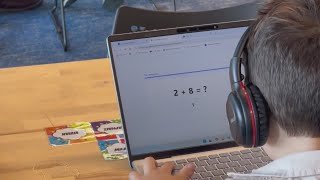U.S. Secretary of Education Linda McMahon toured an Austin private school on Tuesday, which claims it helps students “Learn 2x in 2 Hours.”
Source: Youtube

U.S. Secretary of Education Linda McMahon toured an Austin private school on Tuesday, which claims it helps students “Learn 2x in 2 Hours.”
Source: Youtube

Editor’s Note: This article was written for Mosaic, an independent journalism training program for high school students who report and photograph stories under the guidance of professional journalists.
As a 16-year-old high school student living in the Bay Area, I notice artificial intelligence being used around me daily. At my school, I’ve seen students submitting AI-generated work as their own, rather than taking the time to research, write and truly understand content.
Teachers see this and fear that students will go out in the real world and not know how to think critically without consulting a machine first. They see how it has already created an overreliance on shortcuts, weaker problem-solving skills and lower writing ability in their students. In response, many teachers have banned AI from their classrooms.
I’ll be honest: sometimes I use AI in school, too. By asking ChatGPT to help me explain the meaning of a piece of text or asking it to identify flaws in my writing, I intentionally use AI to help me learn. But when some of my peers use it to generate their entire assignments, it leads teachers to see any use of AI — whether it be productive or exploitative — as a lazy way to cheat, and it makes me feel guilty to use it at all.
It’s understandable why many educators feel this way, and researchers agree. For example, in a 2024 study published by the journal Societies, a sampling of 666 people showed that younger participants reported a higher use of AI tools but displayed lower critical-thinking skills.
However, AI isn’t going away. Other studies show that the use of AI in the workplace and in education is rising. A 2025 Gallup poll of U.S. employees showed those who frequently use AI multiple times a week nearly doubled, from 11% to 19% in two years. It’s only becoming more integrated in the world we live in, and without being taught AI literacy in school, the future feels uncertain.
Completely wiping AI out from classrooms doesn’t work in the long term, because students still find ways to move around it and misuse it for their assignments. It’s easy for them to adapt by using content humanizers like Bypass GPT or AIHumanize to avoid being detected. Banning it does not solve the problem.
A ban also erases the opportunities that AI can give students to do better in school. For example, an English teacher might have students generate an essay using AI, then have them critique its writing style and argument, or compare it to their own essay to identify areas that can be improved.
Khanmigo, an AI platform developed by Khan Academy, can give students more practice problems in math when they struggle with a particular concept, and can work with them to learn, rather than handing them answers.
This is a chance for educators to teach students how to use AI responsibly — not as a substitute for creative and critical thought, but as a tool to support them in academics instead. AI is still a developing technology that presents ethical issues, like its substantial environmental impact and potential biases that can be introduced by algorithms. It’s also known to not always be reliable for credible information and research.
But I rarely see these issues being discussed around me — it’s a missed opportunity for teachers to encourage digital literacy and for students to engage with a technology that will ultimately shape our world.
Sophie Luo is a member of the class of 2027 at Irvington High School in Fremont.
Originally Published:

Launched as part of ACSES’ Australian Student Equity Symposium in Sydney, Equity Insights 2025: Policy, Power, and Practice for a Fairer Australian Tertiary Education System shares the views of vice-chancellors, policymakers, practitioners, and students, who examine why, despite substantial investment and effort, equity progress in Australian higher education remains modest.
Shamit Saggar, executive director of ACSES, said the purpose of the report is to shed light on the challenge of student equity, the responsibilities involved, and the progress being made.
“The report gathers 14 perspectives from key figures involved in higher education policy, university sector management, equity practice, student experience, and academic expertise. Each of these contributions reflects distinct elements of the task facing the sector,” said Saggar.
The report spans three themed sections: Rewriting the System: Policy, Structures and Reform; Power, Voice and Justice; and Making Equity Real: Practice, Place and Participation.
ACSES research and policy program director, Ian Li, said the report discusses the actions required across a broad range of areas. “It highlights both the systemic reforms required and the everyday practices that can make a real difference in the lives of students,” said Li.
[The report] highlights both the systemic reforms required and the everyday practices that can make a real difference in the lives of students
Ian Li, ASCES
The report argues that higher education is still shaped by entrenched class hierarchies, colonial legacies, and rigid divisions between vocational and university pathways, and that incremental reforms have not, and will not, deliver the impact required for the nation to meet the ambitious target of 80% tertiary attainment by 2050, with full parity for underrepresented groups.
Contributors also emphasise that cost-of-living pressures, housing stress, and mental health challenges are not peripheral concerns but central to whether students can complete their studies, and are just as important as reforming admissions or curriculum.
The longstanding divide between vocational education and universities was raised as a key issue, with calls for a harmonised system that allows students to move more easily between sectors and provides more flexible entry and exit points.
The report outlined measures to increase access for regional and remote students, including creating regional study hubs, tailored funding, and localised support outside metropolitan areas. It also called for leveraging the success of regional universities that already serve high proportions of equity students by using them as models for scaling equity.
Disability inclusion, meanwhile, must move beyond individual adjustments toward accessible curriculum and learning environments designed from the outset.
Indigenous contributors Leanne Holt and Tracy Woodroffe called for universities to move beyond transactional support and embed Indigenous leadership and cultural safety at every level of governance, teaching, and research.
Universities were also issued a warning that using AI and technology as a quick fix for equity risks widening the divide further. Instead, the report suggested equity must shape how AI is integrated through universal digital access, AI literacy, and student co-design.
The report also contained early insights from the new National Student Ombudsman, launched in February 2025, revealing strong demand for independent complaint resolution, especially on course administration, wellbeing, and financial issues. Sarah Bendall, who leads the office as First Assistant Ombudsman, argues this is proof that accountability must become a sector-wide priority.
While each section of the report contains unique perspectives and experiences, the overall message of Equity Insights 2025 is not simply to do more, it is to do differently, and it calls for bold leadership across the entire sector.

Effective as of September 6, all nonimmigrant US visa applicants including international students must schedule interviews at their local US embassy or consulate, or face an increased risk of rejection, the State Department has announced.
“Applicants who scheduled nonimmigrant interviews at a US embassy or consulate outside of their country of nationality or residence might find that it will be more difficult to qualify for the visa,” the department warned.
Fees paid for such applications will not be refunded and cannot be transferred, said the department, adding that applicants would have to demonstrate residence in the country where they are applying.
The directive puts an end to a pandemic-era practice of students bypassing long wait times at home by scheduling visa appointments from a third country.
Stakeholders have raised concerns that the new rule could exacerbate wait times and disadvantage students whose local embassies are plagued by delays.
According to State Department data updated last month, individuals applying for student and exchange visitor visas at the US embassy in Abuja, Nigeria, currently must wait 14-months before obtaining an interview.
Meanwhile, the next available F, M, and J visa appointments at consulates in Accra, Ghana and Karachi, Pakistan, are not for another 11 and 10.5 months respectively.
Applicants who scheduled nonimmigrant interviews at a US embassy or consulate outside of their country of nationality or residence might find that it will be more difficult to qualify for the visa
US State Department
The new rule comes after a near month-long pause on new student visa interviews this summer saw major delays and cancelled appointments at embassies across the globe, preventing some international students from enrolling at US colleges this semester.
Enhanced social media vetting for all student visa applications is also believed to be contributing to the delays.
Existing nonimmigrant visa appointments “will generally not be cancelled,” said the department, adding that: “Rare exceptions may also be made for humanitarian or medical emergencies or foreign policy reasons.”
Nationals of countries where the US is not conducting routine visa operations have been instructed to apply at the following designated alternatives:
| National of: | Designated location (s): |
| Afghanistan | Islamabad |
| Belarus | Vilnius, Warsaw |
| Chad | Yaoundé |
| Cuba | Georgetown |
| Haiti | Nassau |
| Iran | Dubai |
| Libya | Tunis |
| Niger | Ouagadougou |
| Russia | Astana, Warsaw |
| Somalia | Nairobi |
| South Sudan | Nairobi |
| Sudan | Cairo |
| Syria | Amman |
| Ukraine | Krakow, Warsaw |
| Venezuela | Bogota |
| Yemen | Riyadh |
| Zimbabwe | Johannesburg |
The State Department did not immediately respond to The PIE’s request for comment.


The Guardian view on Trump and the Fed: independence is no substitute for accountability | Editorial
Building Trust in Military AI Starts with Opening the Black Box – War on the Rocks


SDAIA Supports Saudi Arabia’s Leadership in Shaping Global AI Ethics, Policy, and Research – وكالة الأنباء السعودية


Journey to 1000 models: Scaling Instagram’s recommendation system


Mumbai-based Perplexity Alternative Has 60k+ Users Without Funding


VEX Robotics launches AI-powered classroom robotics system


Happy 4th of July! 🎆 Made with Veo 3 in Gemini


Macron says UK and France have duty to tackle illegal migration ‘with humanity, solidarity and firmness’ – UK politics live | Politics


Kayak and Expedia race to build AI travel agents that turn social posts into itineraries


OpenAI 🤝 @teamganassi